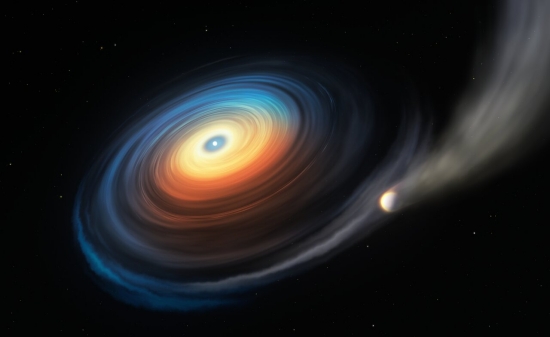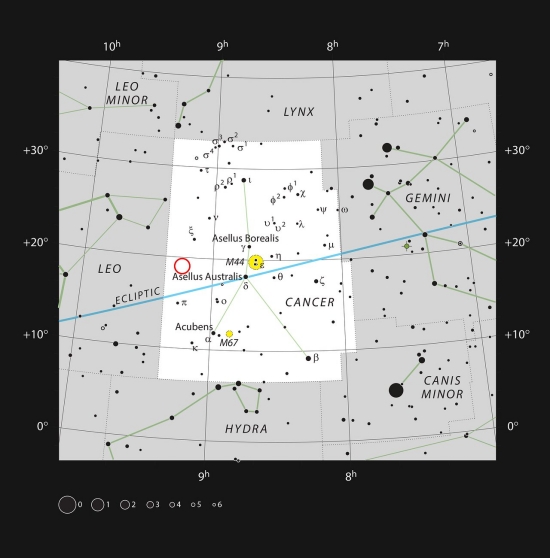Calling it a ‘chance discovery,’ the University of Warwick’s Boris Gänsicke recently presented the results of his team’s study of some 7,000 white dwarf stars, all of them cataloged by the Sloan Digital Sky Survey. One drew particular interest because chemical elements turned up in spectroscopic studies indicating something unusual. Says Gänsicke, “We knew that there had to be something exceptional going on in this system, and speculated that it may be related to some type of planetary remnant.”
And that makes the star WDJ0914+1914 an example of what a stellar system that survived, at least partially, the red giant phase of its host star might look like as a planet orbits the Earth-sized white dwarf. This work, which draws on data from the European Southern Observatory’s X-shooter spectrograph at the Very Large Telescope in Chile, confirms hydrogen, oxygen and sulphur associated with the white dwarf, all found in a disk of gas around the star rather than being present in the white dwarf itself. Subsequent work determined that the only way to produce this particular disk configuration was through evaporation of a giant planet.

Image: Artist’s impression of the WDJ0914+1914 system. Credit: ESO.
Thus this white dwarf makes history as the site of the first detection of a surviving giant planet around this class of star. You’ll recall previous work on white dwarf atmospheres, which has given us a look at the composition of infalling material that may have been the result of the breakup of a planet, comet or asteroid (see, for example, Survivors: White Dwarf Planets).
But now we’re looking at an actual planet in the act of shedding material while still retaining its structure. The oxygen, hydrogen and sulphur found here are similar to what we see in the deeper atmospheric layers of Neptune and Uranus. Placing such a planet in a tight orbit around a white dwarf would cause high levels of ultraviolet radiation to strip away the outer atmospheric layers, creating the same kind of disk we find at WD J0914+1914.
The star’s temperature is estimated at 28,000° Celsius, while the planet is at least twice as large as the star it orbits, a world whose atmosphere is being depleted due to interactions with the star’s high energy photons. While most of the gas escapes, about 3,000 tonnes per second fall onto the disk, which is what makes the presence of the planet accessible to observers.

Image: Location of WDJ0914+1914 in the constellation of Cancer. Credit: ESO.
The planet orbits the primary at a scant 15 times the stellar radius, meaning it is 10 million kilometers away from the star, in a place that would have once been deep inside the red giant that was the white dwarf’s progenitor. The assumption here is that the planet moved closer to the star after the white dwarf had formed, perhaps through gravitational interactions with other worlds in this system. We also get a glimpse of this system’s future in the paper:
Gravitational interactions in multi-planet systems can perturb planets onto orbits with peri-centres close to the white dwarf, where tidal effects are likely to lead to circularisation of the orbit. Common envelope evolution provides an alternative scenario to bring a planet into a close orbit around the white dwarf, though it requires rather fine-tuned initial conditions and only works for planets more massive than Jupiter… As the white dwarf continues to cool, the mass loss rate will gradually decrease, and become undetectable in ~ 350 Myr… By then, the giant planet will have lost ~ 0.002 Jupiter masses (or ~ 0.04 Neptune masses), i.e. an insignificant fraction of its total mass.
The paper also notes a possible analogue to WD J0914+1914 in HAT-P-26b, a Neptune-mass planet orbiting a K-class star with a period of 4.26 days, adding that despite its high temperature, the small radius of WD J0914+1914 would make its planet cooler than the equivalent around a main sequence star. As to how common such planets may be, of the 7,000 white dwarfs examined by this study, only one planet has emerged. The authors point out that we can look forward to studying the roughly 260,000 white dwarfs identified by the Gaia mission, and thus could well find in this larger sample enough planets to make comparative study possible.
The paper is Gänsicke et al., “Accretion of a giant planet onto a white dwarf star,” Nature 576 (2019), 61-64 (abstract / preprint).



Wow. Very unexpected.
The authors estimate that the occurrance rate is ~1 for every 10,000 white dwarf stellar corpses. Since only a small percentage of these are recent enough, and thus hot enough to heat the upper atmosphere of an ice giant sufficiently to achieve escape velocity, only a small percentage of those systems that do occur will actually be detected. However, GAIA has been observing over 250,ooo white dwarfs, so a few more of these planets may pop out by DR7 or so.
Not really. W Thornhill states what he believes as a planetary success inside the envelope of a red dwarf.
And shortly after this announcement, a study investigating the possible dynamical history of the planet:
Veras & Fuller (arXiv:1912.02199 [astro-ph.EP]) “The dynamical history of the evaporating or disrupted ice giant planet around white dwarf WD J0914+1914”
They suggest it is either a very-low-density “super-puff” planet (similar to the planets orbiting Kepler-51), or a more normal ice giant on an eccentric orbit.
Yes wow
One very interesting system to think about, only a small amount of its total mass will be lost.
Now to catch up on the other posts here
Cheers
Speaking of white dwarf stars: Enter – The Astrophysical Journal Letters Volume 881, Number 1 (google it and scroll dovn to the THIRD ITEM). “Self-lensing discovery of a 0.2 White Dwarf in an Unusually Wide Orbit around a Sun-like Star.” by Kento Masuda, Hajime Kawahara, David W. Latham, Allyson Bieryla, Masanobu Kuntino, Morgan MacLeod. KIC8145411B is a white dwarf star orbiting a 15’th magnitude G star at a distance of 1,28 +/- 0.03 AU and transits the primary, lensing some of the primary’s light, making it appear to brighten. However, the orbit of the WD is SO FAR AWAY that none or its material could have been SIPHONED onto the G star during the time period when the WD was in its Red Giant phase. Therefore, the ONLY explanations for this WD currently having SUCH A LOW MASS are as follows – ONE: The WD is 14.8 billion years old(or older than the UNIVERSE ITSELF), TWO: It is either an extremely low mass neutron star/stellar mass black hole, or an extremely high mass primordial black hole. THREE: It is composed of HYPER-EXOTIC particles like strange quarks or axions. FOUR: It is NOT NATURAL, but instead, some kind of ETI beacon. MY TAKE: Eliminating “ONE” and “TWO” out of hand due to sheer impossibility(in my opinion – correct me if I am wrong), I also reject the “strange quark” explanation due to the fact that if any strangelets were around to turn KIC8145411B into a strange quark star, KIC8145411A should have ALSO been turned into one as well. That leaves either an axion star or a space beacon. I choose the former over the latter simply because it is a VIABLE natural explanation, but, please, any Centauri Dreams reader is free to try to argue me out of the natural solution in favor of the non-natural one(I sincerely hope that you succeed).